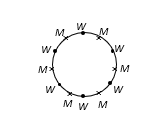Properties of Permutation and combination
When discussing permutation and combination as we are dealing with selection and arrangement with or without order considerations, depending on the situation there are different types and properties for the permutation and combination, these differences among permutations and combinations we will explain here with justified examples.
permutations without repetition
This is the normal permutation which arranges n objects taken r at a time i.e nPr
n Pr=n!/(n-r)!
number of orderings of n different objects taken all at a time n Pn =n!
In addition, we have
nP0 = n!/n!=1
nPr = n.n-1Pr-1
0!=1
1/(-r)!= 0 or (-r)!=∞
permutations with repetition
Number of permutations (arrangements) for different items, taken r at a time, where each item can happen once, twice, three times, …….. r-times as many in any arrangement = Number of ways to fill r areas where each item can be filled with any of the n items.

The number of permutations = The number of ways of filling r places = (n)r
The number of orders that can be organized using n objects out of which p are alike (and of one kind) q are alike (and of another kind), r are similar (and of another kind) and the rest are distinct is nPr =n!/(p!q!r!)
Example:
In how many ways can 5 apples be allocated among four boys when every boy can take one or more apples.
Solution: This is the example of permutation with repetition as we know that for such cases we have
The number of permutations = The number of ways of filling r places =nr
Required number of ways are 45 =10, Since each apple can be distributed in 4 ways.
Example: Find the number of words can be organized with the letters of the word MATHEMATICS by regrouping them.
Solution: Here we can observe that there are 2 M’s, 2 A’s and 2T’s this is the example of permutation with repetition
=n!/(p!q!r!)
Required number of ways are =11!/(2!2!2!)=4989600
Example: How many ways in which the number of tails equal to the number of heads if six identical coins are arranged in a row.
Solution: Here we can observe that
No. of heads=3
No. of tails =3
And since coins are identical this is the example of permutation with repetition =n!/(p!q!r!)
Required number of ways =6!/(3!3!)= 720/(6X6)=20
Circular permutation:
In circular permutation, most importantly the ordering of the object is respect to the others.
So, in circular permutation, we adjust the position of one object and arrange the other objects in all directions.
Circular permutation is split into two ways:
(i) Circular permutation where clockwise and anti-clockwise settings suggest different permutation, e.g. Arrangements for seating people around the table.
(ii) Circular permutation where clockwise and anti-clockwise settings display same permutation, e.g. arranging certain beads to create a necklace.
Clockwise and anti-clockwise arrangement
If the anti-clockwise and clockwise order and movement are not different eg, bead arrangement in necklace, flower arrangement in garland etc, then the number of circular permutations of n distinct items is (n-1)!/2
- The number of circular permutation for n different items, taken r at a time, when the orders for the clockwise and the anti-clockwise are considered to be different by nPr /r
- The number of circular permutation for n different items, taken r at a time, when clockwise and anti-clockwise orders are not different from nPr /2r
- The number of circular permutations of n different objects are (n-1)!
- The number of ways in which n different boys can be seated round a circular table is (n-1)!
- The number of ways in which n different gems can be set up to form a necklet, is (n-1)!/2
Example:
How many ways can five keys be placed in the ring
Solution:
Since clockwise and anticlockwise are same in case of ring.
If the anti-clockwise and clockwise sequence and movement are not different then the number of circular permutations of n distinct items is
=(n-1)!/2
Required number of ways = (5-1)!/2= 4!/2=12
Example:
What would be the number of arrangements, If eleven members of a committee sit at a round table so that the President and Secretary always sit together.
Solution:
By fundamental property of circular permutation
The count of circular permutations of n different things are (n-1)!
Since two positions are fix so we have
Required number of ways (11-2)!*2=9!*2=725760
Example: What would be number of ways 6 men and 5 women can eat at a round table if no two women can sit together
Solution: By fundamental property of circular permutation.
The count of circular permutations of n different things are (n-1)!
Number of ways in which 6 men can be arranged at a round table = (6 – 1)! =5!

Now women can be arranged in 6! ways and Total Number of ways = 6! × 5!
Combinations without repetition
This is the usual Combination which is “The number of combinations (selections or groups) that can be formed from n different objects taken r at at a time is nCr =n!/(n-r)!r!
Also nCr =nCr-r
n Pr /r! =n!/(n-r)! =nCr
Example: Find the number of options to fill 12 vacancies if there are 25 candidates and five of them are from the scheduled category, provided that 3 vacancies are reserved for the S.C candidates mean while the remaining are open to everyone.
Solution: Since 3 vacant positions are filled from 5 applicants in 5 C3 ways (i.e 5 CHOOSE 3) and now remaining candidates are 22 and remaining seats are 9 so it would be 22C9 (22 CHOOSE 9) The selection can be made in 5 C3 X 22C9 ={5!/3!(5-3)! }X{22!/9!(22-9)!}
5 C3 X 22C9 = {(3!X4X5)/(3!X2!)}X {22!/(9!X13!)}=4974200
So the selection can be made in 4974200 ways.
Example: There are 10 candidates and three vacancies in the election. in how many ways a voter can cast his or her vote?
Solution: Since there are only 3 vacancies for 10 candidates so this is the problem of 10 CHOOSE 1, 10 CHOOSE 2, and 10 CHOOSE 3 Examples,
A voter can vote in 10C1+10C2+10C3 = {10!/1!(10-1)!}+{10!/2!(10-2)!}+{10!/3!(10-3)!} =10+45+120= 175 ways.
So in 175 ways voter can vote.
Example:There are 9 chairs in a room for 4 people, one of which is a single-seat guest with one specific chair. How many ways can they sit?
Solution: Since 3 chairs can be select in 8C3 and then 3 persons can be arranged in 3! ways.
3 persons are to be seated on 8 chairs 8C3 (i.e 8 CHOOSE 3) arrangement
=8C3 X3! = {8! /3!(8-3)!} X3!
=56X6=336
In 336 ways they can sit.
Example: For five men and 4 women, a group of 6 will be formed. In how many ways this can be done so that the group has more men.
Solution: Here the problem include different combinations like 5 CHOOSE 5, 5 CHOOSE 4, 5 CHOOSE 3 for men and for women it include 4 CHOOSE 1, 4 CHOOSE 2 and 4 CHOOSE 3 as given in the followings
1 woman and 5 men =4C1 X 5C5 ={4!/1!(4-1)!} X{5!/5!(5-5)!}=4
2 women and 4 men =4C2 X 5C4 = {4!/2!(4-2)!} X{5!/4!(5-4)!}=30
3 women and 3 men =4C3 X 5C3 = {4!/3!(4-3)!} X {5!/3!(5-3)!} =40
Hence total ways = 4+30+40=74.
Example: The number of ways 12 boys can travel in three cars so that 4 boys in each car, assuming that three particular boys will not go in the same car.
Solution: First omit three particular boys, remaining 9 boys may be 3 in each car. This can be done in 9 CHOOSE 3 i.e 9C3 ways,
The three particular boys may be placed in three ways one in each car. Therefore total number of ways are =3X9C3.
={9!/3!(9-3)!}X3= 252
so in 252 ways they can be placed.
Example: How many ways did 2 green and 2 black balls come out of a bag containing 7 green and 8 black balls?
Solution: Here bag contains 7 green from that we have to choose 2 so it is 7 CHOOSE 2 problem and 8 black balls from that we have to choose 2 so it is 8 CHOOSE 2 problem.
Hence the Required number = 7C2 X 8C2 = {7!/2!(7-2)!}X{8!/2!(8-2)!}=21X28=588
so in 588 ways we can select 2 green and 2 black from that bag.
Example: Twelve different characters of English words are provided. From these letters, 2 alphabetical names are formed. How many words can be created when at least one letter is repeated.
Solution: here we have to choose 2 letter words from 12 letters so it is 12 CHOOSE 2 problem.
No. of words of 2 letters in which letters have been recurrent any times = 122
But no. of words on having two different letters out of 12 =12C2 = {12!/2!(12-2)!} =66
Required number of words = 122-66=144-66=78.
Example: There are 12 points on the plane where six are collinear, then how many lines can be drawn by joining these points.
Solution: For 12 points in a plane to make line we require 2 points same for six collinear points, so this is 12 CHOOSE 2 and 6 CHOOSE 2 problem.
The number of lines is = 12C2 – 6C2 +1={12!/2!(12-2)!}-{6!/2!(6-2)!}+1 =66-15+1=52
So in 52 number of ways it lines can be drawn.
Example: Find the numeral of ways in which a 6-member cabinet can be set up from 8 gentlemen and 4 ladies so that the cabinet consists of at least 3 ladies.
Solution: For forming the committee, we can choose from 3 each men and women and 2men 4 women so the problem includes 8 CHOOSE 3, 4 CHOOSE 3, 8 CHOOSE 2 and 4 CHOOSE 4.
Two types of cabinet can be formed
(i) Having 3 men and 3 ladies
(ii) Having 2 men and 4 ladies
Possible no. of ways = (8C3 X 4C3) + (8C2 X4C4)= {8!/3!(8-3)!}X{4!/3!(4-3)!} +{8!/2!(8-2)!}X{4!/4!(4-4)!} = 56X4+ 28X1 =252
So In 252 ways we can form such cabinet.
These are some examples where we can compare the situation of nPr vs nCr in the case of permutation, the way things are organized is important. However in Combination the order means nothing.
Conclusion
A brief description of Permutation and combination when repeated and non-repeated with the basic formula and important results is provided in the form of real examples, in this series of articles we will discuss in detail the various outcomes and formulas with relevant examples, if you want to continue reading:
SCHAUM’S OUTLINE OF Theory and Problems of DISCRETE MATHEMATICS
https://en.wikipedia.org/wiki/Permutation
https://en.wikipedia.org/wiki/Combination
For more Article on Mathematics, please follow this Link

I am DR. Mohammed Mazhar Ul Haque. I have completed my Ph.D. in Mathematics and working as an Assistant professor in Mathematics. Having 12 years of experience in teaching. Having vast knowledge in Pure Mathematics, precisely on Algebra. Having the immense ability of problem design and solving. Capable of Motivating candidates to enhance their performance.
I love to contribute to Lambdageeks to make Mathematics Simple, Interesting & Self Explanatory for beginners as well as experts.